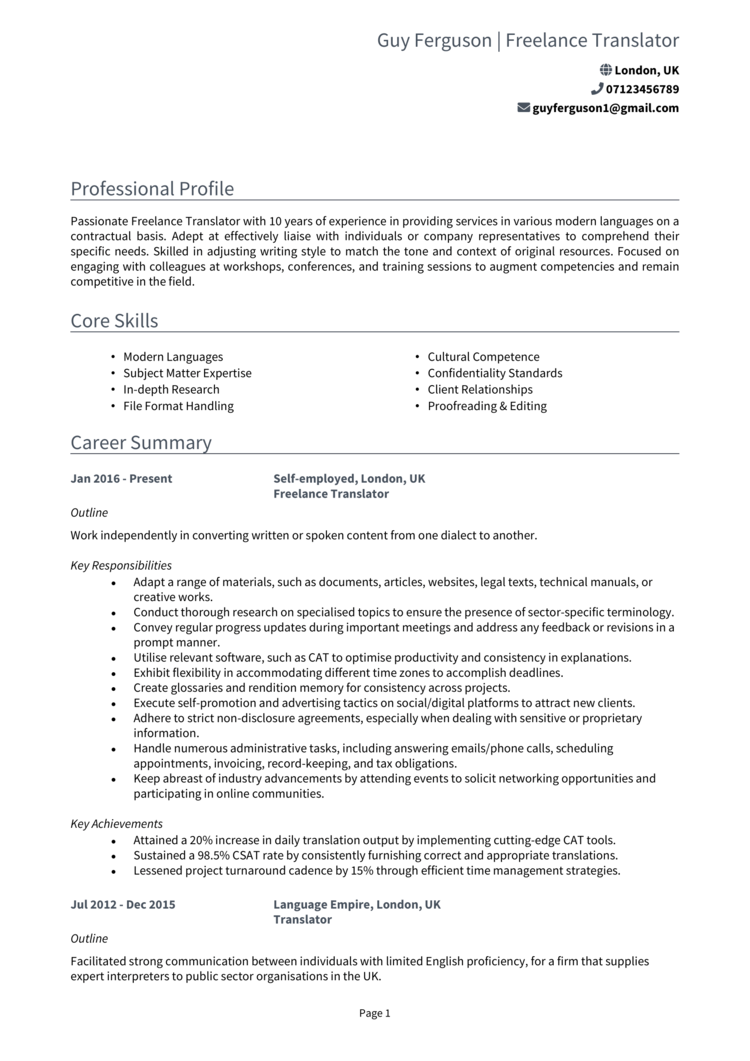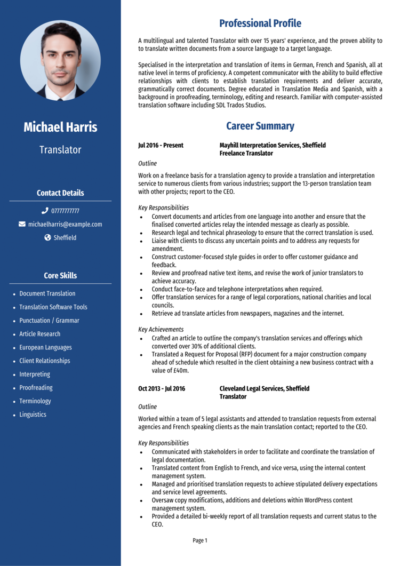Being a translator isn’t just about swapping words from one language to another – you’ll be bridging cultures and making communication seamless. For this rewarding job, you’ll need a CV that doesn’t get lost in translation, and makes sure recruiters understand why you’re the perfect candidate.
These Translator CV examples will show you how to write your own application, along with a writing guide which will help showcase your linguistic expertise and highlight your cultural awareness in order to land you interviews for the best roles in the industry.
Translator CV example

Freelance Translator CV example

How to write your Translator CV
Learn how to create your own interview-winning Translator CV with this simple step-by-step guide.
With the right CV, you won’t just break language barriers – you’ll break into your dream job. Employers want to see that you can handle complex texts, deliver accurate translations, and maintain the tone and meaning of the original.
This guide will teach you how to write a CV that makes your skills shine, helps you get noticed, and secures opportunities in a variety of translation fields.
The correct structure for a Translator CV


Your CV structure should be as precise and well-structured as your translations, with just as few typos and avoidable mistakes. A clear layout ensures that hiring managers can easily spot your skills, qualifications, and experience.
Here’s how you should structure your Translator CV:
- Name and contact information – Your contact details should be at the top so recruiters can reach you easily. You’re able to add a picture of yourself, but it’s optional.
- Profile – Open with a summary of your language expertise, experience, and career goals in your CV profile.
- Core skills – Concisely highlight your abilities, from fluency in specific languages to technical translation tools.
- Work experience – Run through your roles in reverse chronological order, focusing on your key projects and responsibilities.
- Education – Make a note of your academic qualifications, language certifications, and relevant training and awards.
- Additional info – You could optionally outline your hobbies and interests that reflect cultural awareness or linguistic passion.
Translator CV format


A messy CV format is like a mistranslated menu – confusing, frustrating, and possibly hilarious for all the wrong reasons. Keep it sleek and professional: a polished format ensures employers focus on your skills, not the design.
Here’s how to format your Translator CV effectively:
- Bullet points – Use concise, clear points to outline your responsibilities and achievements.
- Divide sections – Make use of distinct headings and logical spacing to guide recruiters through your CV.
- Use a clean font – Opt for a clean, clear font to make your CV polished and easy to read.
- Keep it the right length – 2 pages is the perfect length to cover the essentials without getting boring. You can add any extras to your cover letter.
The best way to write a Translator CV profile


Your CV profile (known as your personal statement if you’re a newer candidate) is like the opening line of a novel – it needs to draw the recruiter in and make them want to keep reading. It should quickly summarise your best skills and demonstrates why you’re the perfect translator for the role.
Translator CV profile examples
Profile 1
Experienced Translator with six years of expertise in translating legal and financial documents between English and Spanish. Proficient in maintaining accuracy and cultural relevance, ensuring compliance with industry standards. Delivered high-quality translations that improved client communication and facilitated successful international transactions.
Profile 2
Organised Translator with four years of experience translating technical manuals and user guides from German to English for the manufacturing sector. Skilled in terminology research, localisation, and quality assurance, contributing to clear and effective communication for global audiences.
Profile 3
Proficient Translator with over eight years of experience specialising in literary and creative translations from French to English. Adept at capturing the tone and style of original works, delivering nuanced translations that resonate with readers. Successfully translated five published novels and numerous short stories.
What to include in your Translator CV profile
Here are some tips on what to include in your Translator CV profile:
- Where you’ve worked – Mention the sorts of companies, agencies, or freelance clients you’ve translated for.
- Your top qualifications – Tell recruiters about your certifications like a degree in Translation or a recognised language qualification.
- Key languages – Quickly mention your fluency in the languages relevant to the role.
- Specialised fields – Note any areas of expertise, like legal, medical, or technical translation.
- Notable achievements – Also include highlights like translating published works or delivering error-free translations under tight deadlines.
Core skills section


The CV skills section is your linguistic toolkit – a showcase of the skills that make you the one to call when words matter most. Tailor this section to align with the role’s focus, whether it’s literary translation, technical documentation, live interpretation, and so on.
Top skills for your Translator CV
- Language Proficiency – Expert fluency in both source and target languages for accurate and nuanced translations.
- Cultural Adaptation – Ensuring translations are culturally appropriate and sensitive to regional differences.
- Specialised Terminology – Knowledge of technical vocabulary in fields like legal, medical, or technical translation.
- CAT Tools Expertise – Proficiency in using Computer-Assisted Translation (CAT) tools like Trados, MemoQ, or Wordfast.
- Document Translation – Translating written texts such as contracts, manuals, or marketing materials with precision.
- Interpretation – Providing real-time verbal translation in settings such as meetings, conferences, or courtrooms.
- Proofreading and Editing – Reviewing translations for grammar, syntax, and accuracy to maintain high-quality standards.
- Multilingual SEO – Adapting content for global audiences while optimising for search engines in different languages.
- Subtitling and Transcription – Creating subtitles and transcriptions for videos, ensuring timing and accuracy.
- Industry Compliance – Adhering to confidentiality agreements and ethical standards in all translation projects.
Work experience


Your work experience section is where you show how you’ve applied your linguistic skills to deliver accurate and meaningful translations. Recruiters will appreciate candidates with practical experience, so emphasise the specific duties and the value you provided.
List them off with the newest ones at the top, giving more detail to the most relevant roles.
Writing job descriptions for past roles

- Outline – Give a brief description of the organisation, your role, and the types of texts you translated.
- Responsibilities – Highlight your key tasks, such as translating legal documents, localising websites, or interpreting at events. A good CV will use action verbs where possible.
- Achievements – Add measurable outcomes, such as successful project completions or client satisfaction rates.
Job examples for Translators
Translator | Global Docs Solutions
Outline
Translated legal and business documents for a translation agency specialising in international contracts and compliance. Focused on ensuring linguistic accuracy and cultural sensitivity to meet client needs.
Responsibilities
- Translated contracts, financial reports, and compliance documents between English and Spanish.
- Conducted in-depth research on legal terminology to ensure precise translations.
- Collaborated with clients to clarify ambiguous terms and confirm contextual accuracy.
- Reviewed and edited translations to ensure consistency and adherence to style guides.
- Maintained confidentiality and data security in handling sensitive documents.
Achievements
- Completed over 500 translation projects with a 99 percent client satisfaction rate.
- Reduced turnaround times by 20 percent through efficient workflow management.
- Praised by clients for consistently delivering accurate and culturally appropriate translations.
Freelance Translator | TechTrans Manuals
Outline
Translated technical documentation for a manufacturing company, ensuring clarity and usability for international customers. Focused on localisation and maintaining consistency across materials.
Responsibilities
- Translated technical manuals, safety guidelines, and product specifications from German to English.
- Ensured consistent terminology usage by maintaining and updating glossaries.
- Collaborated with engineers to verify the accuracy of technical descriptions.
- Localised content to suit regional market requirements while retaining technical integrity.
- Provided quality assurance by reviewing translations for linguistic and factual accuracy.
Achievements
- Improved customer satisfaction scores by 15 percent through clear and user-friendly translations.
- Reduced editing time by 30 percent by implementing a streamlined glossary system.
- Recognised by management for delivering high-quality translations under tight deadlines.
Translator | Global Publishing
Outline
Specialised in literary translation for a publishing house, focusing on French-to-English translations of novels, short stories, and poetry. Ensured faithful representation of the original author’s voice and intent.
Responsibilities
- Translated five published novels and numerous short stories, maintaining the stylistic nuances of the original texts.
- Conducted cultural and historical research to accurately convey context and meaning.
- Collaborated with editors to refine translations and meet publishing standards.
- Adapted idiomatic expressions and metaphors to resonate with English-speaking audiences.
- Prepared supplementary materials, including footnotes and author interviews, for publication.
Achievements
- Achieved critical acclaim for the translation of an award-winning French novel.
- Increased sales of translated works by 25 percent through culturally resonant translations.
- Praised by authors for preserving their creative intent and style in English versions.
Education section


Whether you’ve mastered linguistics at university or learned through endless Duolingo streaks, this section is where you show off your language credentials. The education section is vital for translators, as it demonstrates your academic background and linguistic training.
Briefly outline your degrees, certifications, and relevant training in language studies or translation techniques. If you’re newer to the field, highlight coursework, language immersion programs, or self-study achievements.
Always list qualifications in reverse chronological order, starting with the most recent.
What are the best qualifications for a Translator CV?
- Bachelor’s Degree in Translation or Linguistics – Provides foundational knowledge of translation theory and practice.
- Certified Translator Accreditation (CIOL, ATA) – Highlights professional competence in translation.
- Diploma in Public Service Interpreting (DPSI) – Focuses on interpreting for government and public sectors.
- Proficiency Certificates (e.g., DELF, DELE) – Validates advanced fluency in specific languages.
- Machine-Assisted Translation (MAT) Tools Training – Demonstrates expertise in software like Trados or MemoQ.





